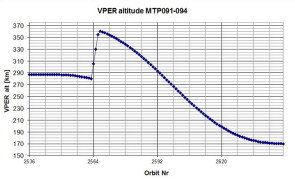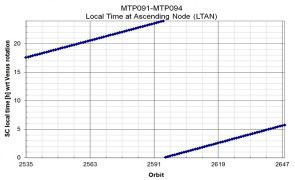No. 260 - Automation of spacecraft passes, thermal fuel gauging tests, start of the twenty-fourth solar eclipse season and the fifteenth Earth occultation season
Cebreros ground station
All Cebreros ground station activities were nominal during this reporting period. Routine monthly maintenance was carried out on 7 and 8 May 2013. This reduced slightly the downlink time available on those days. On 29 April, the presence of ice on the antenna panels caused a late acquisition of signal (AOS) at Cebreros. Spacecraft controllers in Germany worked around this by checking the spacecraft status via the ESA ground station in New Norcia, Australia for a short time until the problem was resolved.
High accuracy spacecraft ranging
ESA's Cebreros and New Norcia ground stations were used for a Delta Differential One-way Ranging (delta-DOR, or DDOR) measurement at the start of the Cebreros communications pass on 24 May. Delta-DOR measurements are carried out with the Venus Express spacecraft on a regular basis to support the accurate determination of the ephemeris for planet Venus that is maintained by NASA's Solar System Dynamics Group.
Spacecraft clock synchronised
The clock on the Venus Express spacecraft is a simple count-up timer, typical of those used on spacecraft. These clocks save weight and cost but they tend to drift, and must be synchronised – or correlated – with atomic clocks on Earth at regular intervals. One of these regular time correlations was performed on 11 May after the Cebreros communication pass. The new time correlation was applied starting from 11 May at 17:10 UTC.
Automating spacecraft passes at the Mission Operations Centre
Technology is allowing increased efficiency in many areas, and one of those areas is spacecraft operations at ESA's European Space Operations Centre (ESOC) in Darmstadt, Germany. The Venus Express mission is now phasing in the operation of new software that allows the automation of routine daily contact with the spacecraft. A single spacecraft controller can then oversee communications with multiple spacecraft, with human intervention only required if the spacecraft response differs from expected behaviour.
One automated pass was scheduled during this planning period, on 8 May 2013. The new system will be used for all passes once the software and various supporting processes are certified.
Thermal fuel gauging tests
Fuel gauging tests that help determine the exact amount of fuel and oxidizer remaining on board the spacecraft are currently underway on Venus Express. A number of these tests will be conducted over the next few months, as and when time can be spared. The early tests were used to obtain calibration data on various sensors. A full test was started during this reporting period to obtain data to be used to calculate the fuel and oxidizer levels. A thermal gauging characterisation period began on 11 May and the test was completed on 23 May.
For more information on the thermal gauging tests, see Venus Express Status Report 259.
Start of the twenty-fourth eclipse season
The twenty-fourth eclipse season started on 30 April and the Earth occultation season started on 9 May. The Venus-Earth-spacecraft geometry was such that some Earth occultations and solar eclipses occurred simultaneously, after orbit pericentre.
Particular science observations are carried out during eclipse seasons: for further details, see the Scientific Focus section below and 'Science observations with Venus Express during an eclipse'.
Start of the fifteenth Earth occultation season
The fifteenth Earth occultation season started during this reporting period, on 9 May. The spacecraft radio signal (used for radio science occultation observations) is received on Earth at the New Norcia ground station in Australia. New Norcia is specifically used for radio science because it has the best viewing angle to Venus when the spacecraft is at pericentre (the Venus Express orbit is 24 hours long).
For short periods of time during Earth occultation seasons, the spacecraft's radio signal can pass through Venus' atmosphere before it is received on Earth. These periods are exploited for unique radio science measurements of Venus' atmosphere. For more information, please see the Scientific Focus section (below) and 'Venus Express Earth occultation seasons'.
Orbit correction manoeuvres
Four orbit correction manoeuvres (OCMs) were carried out during this operating period. The first was performed on 28 April and three more carried out over the following three days (29 April, 30 April and 1 May). These burns were carried out at apocentre to adjust the height of the spacecraft's pericentre (closest approach to the planet). At this stage of the mission, with low fuel levels on the spacecraft, the orbit correction manoeuvres are carried out as a number of small burns – rather than fewer large burns – to ensure that they are performed accurately. An explanation for this can be found in Status Report no. 257.
The OCMs carried out during this reporting period were 'hot: during the OCM, the attitude of the spacecraft was such that one or more of the spacecraft's thermally-sensitive faces were exposed to the Sun. The burn orientations therefore heated up the spacecraft and it was necessary to provide for a subsequent cooling period. 'Hot' science observations could not be carried out after the manoeuvres, until after at least 8.5 hours in 'cool' attitudes, where the Sun did not illuminate a thermally sensitive spacecraft face.
Summary of main activities
The table below shows a chronology of the main spacecraft bus activities in the reporting period.
| Main activities during reporting period | |||
| AOS = Acquisition of Signal; CEB = Cebreros; DOR = Differential One-way Ranging; DOY = Day of year; MET = Mission elapsed time; NNO = New Norcia; OCM = Orbit Correction Manoeuvre | |||
|
MET (Day) |
Date | DOY | Main Activity |
| 2728 | 28-Apr-2013 | 118 | CEB communication pass. OCM at apocentre. |
| 2729 | 29-Apr-2013 | 119 | CEB communication pass. OCM at apocentre. Late AOS at CEB dues to ice on the antenna. |
| 2730 | 30-Apr-2013 | 120 | CEB communication pass. OCM at apocentre. Start of eclipse season. |
| 2731 | 01-May-2013 | 121 | CEB communications pass. OCM at apocentre. |
| 2732 | 02-May-2013 | 122 | CEB communications pass. |
| 2733 | 03-May-2013 | 123 | CEB communications pass. |
| 2734 | 04-May-2013 | 124 | CEB communications pass. |
| 2736 | 06-May-2013 | 126 | CEB communications pass. |
| 2737 | 07-May-2013 | 127 | Shortened CEB communications pass due to maintenance. |
| 2738 | 08-May-2013 | 128 | Shortened CEB communications pass due to maintenance. Automated pass. |
| 2739 | 09-May-2013 | 129 | Start of the fifteenth Earth occultation season. CEB communication pass. NNO pass. |
| 2740 | 10-May-2013 | 130 | CEB communications pass. NNO occultation pass. |
| 2741 | 11-May-2013 | 131 | CEB communication pass. Start of thermal gauging characterisation period. |
| 2742 | 12-May-2013 | 132 | CEB communication pass. NNO occultation pass. |
| 2743 | 13-May-2013 | 133 | CEB communication pass. |
| 2744 | 14-May-2013 | 134 | CEB communication pass. NNO occultation pass. |
| 2745 | 15-May-2013 | 135 | CEB communication pass. |
| 2746 | 16-May-2013 | 136 | Telemetry to 76 kbps before AOS of CEB communication pass. NNO occultation pass. |
| 2747 | 17-May-2013 | 137 | CEB communication pass. |
| 2748 | 18-May-2013 | 138 | CEB communication pass. NNO occultation pass. |
| 2749 | 19-May-2013 | 139 | CEB communication pass. |
| 2750 | 20-May-2013 | 140 | CEB communication pass. NNO occultation pass. |
| 2751 | 21-May-2013 | 141 | CEB communication pass. |
| 2752 | 22-May-2013 | 142 | CEB communication pass. NNO occultation pass. |
| 2753 | 23-May-2013 | 143 | CEB communication pass. Thermal gauging fuel test completed. |
| 2754 | 24-May-2013 | 144 | CEB communication pass. NNO occultation pass. Delta-DOR with NNO and CEB. |
| 2755 | 25-May-2013 | 145 | CEB communication pass. |
At the end of the reporting period on 25 May, Venus Express was 246 million kilometres from Earth. The one-way signal travel time was 821 seconds. The final oxidizer mass was 18.329 kg and the final fuel mass was 11.210 kg
Scientific focus
This reporting period falls under the 92nd medium term plan (MTP), which covered the period from 28 April to 25 May 2013. Venus Express was still far from Earth, having recently passed superior conjunction, so the data rate was very low. This MTP saw the start of the twenty-fourth eclipse season on 30 April, and the start of the fifteenth Earth occultation season on 9 May.
The MTP was cold, so that pointing the +Z instrument face of the spacecraft at nadir did not expose any of its thermally sensitive faces to the Sun, making more observations possible. Local time at ascending node (LTAN) changed from 20:45 hrs to 23:45 hrs during this reporting period. For more information on LTAN, please see 'Terminator Orbits'.
While the spacecraft is in the shadow of the planet during solar eclipses, the Venus Monitoring Camera (VMC) can make use of an infrared 'window' in the clouds to obtain low resolution images of the surface. Ishtar Terra, W. Eistla Regio, and Dione Regio in the southern hemisphere were accessible for observations during this MTP. However, due to a focus on surface observations during the previous eclipse season, nightside observations of Nitrogen Oxide were prioritised this time around.
The Solar Occultation at Infrared (SOIR) channel of the SPICAV instrument (Spectroscopy for Investigation of Characteristics of the Atmosphere of Venus) is specially designed to measure atmospheric absorption by observing the Sun through the Venusian atmosphere. Known as occultation observations, these can only be obtained during eclipse seasons, which is why they have high scientific priority eclipse periods. During this reporting period, SOIR ingress or egress observations were obtained in roughly half the orbits.
In addition to SOIR observations, the SPICAV instrument team planned Nitrogen Oxide measurements during the eclipses and the Venus Radio science experiment (VeRa) team had planned observations during the Earth occultation period. As the part of the eclipse overlapped with the Earth occultation period, VeRa radio science occultation, SPICAV Nitrogen Oxide, and SPICAV/SOIR observations were alternated during this MTP.
Payload activities
| ASPERA |
The instrument was regularly operated nominally as part of the routine plan. A previously observed instrument anomaly recurred on 11 May. The spacecraft's Data Management System (DMS) detected a corrupted ASPERA data packet, and the remainder of the observation was lost. The instrument turned itself off and restarted normally at the beginning of the next scheduled observation. |
| MAG | The instrument was regularly operated nominally as part of the routine plan. |
| PFS | The instrument was not operated. |
| SPICAV | The instrument was regularly operated nominally as part of the routine plan. |
| VMC |
The instrument was regularly operated nominally as part of the routine plan. A previously observed anomaly recurred on 12 May when one command to the camera was not acknowledged correctly. The instrument was restarted and worked fine again. |
| VeRa | The instrument was regularly operated nominally as part of the routine plan. |
| VIRTIS | The instrument was regularly operated nominally as part of the routine plan. |
Future milestones
- Start of routine daily automated spacecraft passes
- Start of the twelfth Atmospheric Drag Experiment campaign
- End of the fifteenth Earth occultation season
Legal disclaimer
This report is based on four ESOC mission operations reports, MOR 387 through MOR 390, as well as the MTP 92 Master Science Plan. Please see the copyright section in the Terms and Conditions for this site.






